For years, we didn’t know the true story of how Red Dwarf‘s first episode was made. Not really.
I mean, we thought we did. Blah blah script rejected by the BBC for years, blah blah eventually accepted at BBC Manchester, blah blah electrician’s strike, blah blah remounted in late 1987, blah blah atom bomb. We also knew the rough pattern for the recordings: rehearse at Acton for four days, go up to Manchester for two days of recording – a pre-record day on the Saturday, then the audience record day for the Sunday. Then most people had Monday off, and then back to work rehearsing the next episode on Tuesday. Simple.
That is, until the big revelation. In 2007, a rather curious DVD set was released. Titled Red Dwarf: The Bodysnatcher Collection, this was a grab bag full of Dwarf stuff which – for various reasons – didn’t make it onto the original DVD releases. And one of these features was a proper, in-depth documentary about Series 1 of the show.
ROB GRANT: At the end of the recording of the first series, we had a spare recording day – including a day’s pre-VT – so we could do a whole other show.
PAUL JACKSON: I knew it was there. And I think I maybe even discussed with them [Rob Grant and Doug Naylor], you know, we might have to do a seventh script, and that wasn’t really very practical. So we devised this rather cunning plan of using that last week to go back and do pick-ups for the rest of the series. And again, because the BBC worked in these blocks and then didn’t really monitor it very carefully, nobody noticed, in effect. And we just delivered six.“The Beginning”, Red Dwarf: The Bodysnatcher Collection
Most of those pick-ups were for that first episode, “The End”; in fact, well over half of the episode was reshot. And in an instant, this changed a vast chunk of what we thought we knew about the production of that first episode of Red Dwarf. From a programme recorded on the weekend of the 26th/27th September 1987, it now also became a programme where huge sections were re-recorded on the 7th/8th November 1987.
This is something which – as far as I’m aware – every single piece of writing about the show up until this point had missed. I co-ran a Red Dwarf website for years, and I certainly hadn’t been aware of it before. We knew there had been reshoots, sure – some examples of this had shown up on the first series DVD back in 2002 – but the information about there being entire extra week of production was brand new.1
Of course, what would be lovely is if we could see “The End” as it was originally recorded, without the reshoots… and brilliantly, we can. The Bodysnatcher release also included a feature called “The End: The Original Assembly”, a newly-edited together version of the episode, featuring only footage recorded during the first weekend of shooting. By now, it’s surely becoming clear why The Bodysnatcher Collection is one of my favourite DVD releases ever.2 It is to my eternal regret that it did not inspire more DVD releases of the same type for other shows.
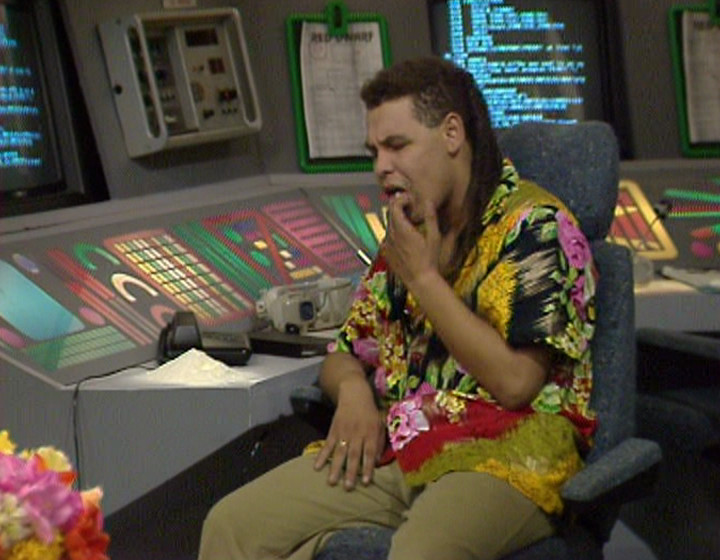
“The End”, Original Shoot
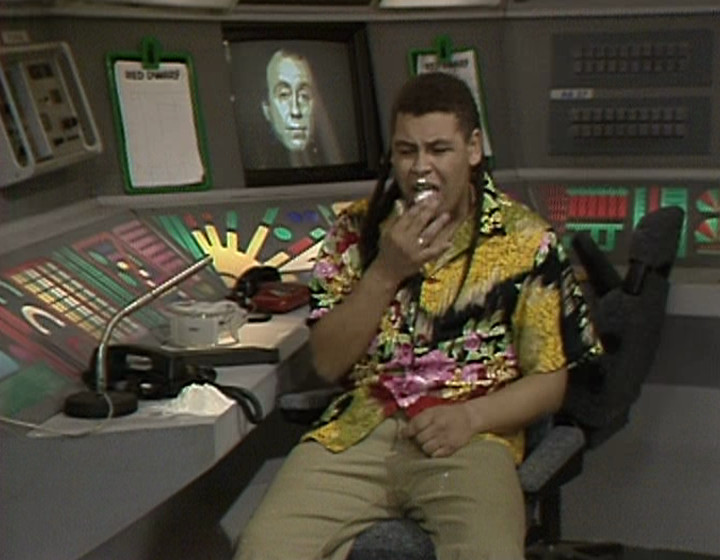
“The End”, Reshoot
What’s a little strange about all this is that if you think about it, it’s weird that any of it became secret. One day of these reshoots was done in front of an audience, after all. It was a public event. If you’d been sitting in a pub near the BBC Manchester studios in Oxford Road, you might have been dragged in to make up the numbers. Hundreds of people sat there and watched these reshoots. It’s odd what fades from the public memory when nobody is really looking. And back in 1987, this stuff was not being documented by an obsessive fanbase.
The Bodysnatcher Collection has long since been deleted, but most of the really interesting stuff from it – including everything I mention above – is available on the Red Dwarf Blu-ray release from 2018. That Blu-ray is not a product I can wholeheartedly recommend for various reasons beyond the scope of this article, but it’s worth it for the Bodysnatcher stuff alone, really.
* * *
That first episode of Red Dwarf was broadcast on the 15th February 1988. Just three months later, the team were already shooting Series 2, for transmission later in the year. That series proved to be pivotal for any number of reasons for Red Dwarf… and also contained one of its most celebrated sequences.
The final episode of the run was called “Parallel Universe”. Not that you would know that from watching the show; you’d have to read the Radio Times to get the episode title. Because instead of the normal title sequence, Red Dwarf decided to spring an original song on the audience.
Hello there, “Tongue Tied”.
There’s a great article that could be written about “Tongue Tied”, from its original form in Grant Naylor sketch show Son of Cliché (broadcast on Radio 4 in October 1983), through to Danny John-Jules’ 1993 single release, and beyond into a recurring part of Dwarf fandom. This is not that article. Instead, I want to focus on just one aspect of the song’s production.
And the key to that particular story is… this.
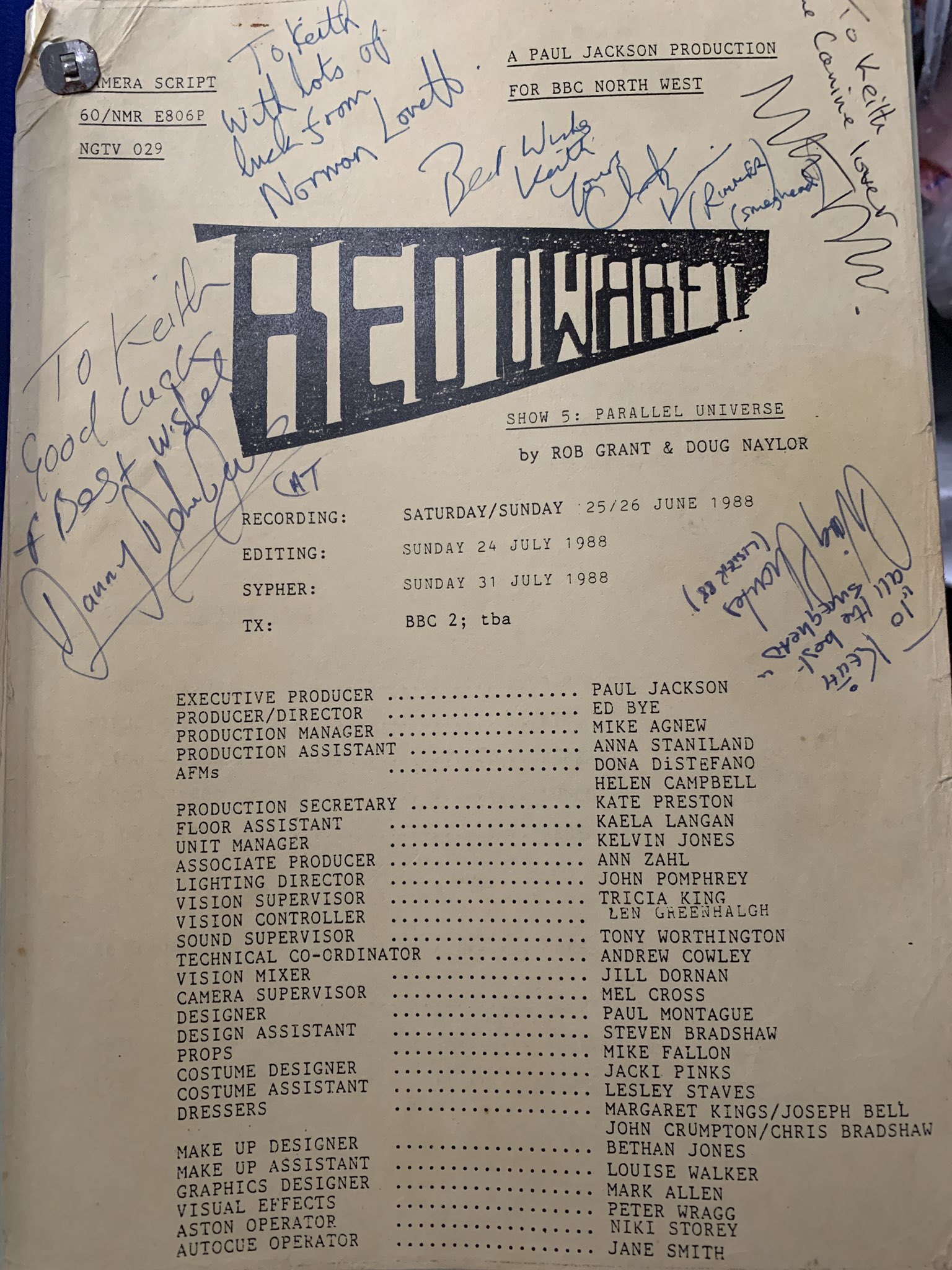
Back in 2019, I got chatting with a very nice chap called Keith Jacobsen, who you will be unsurprised to hear worked on Series 2 of Red Dwarf. Yes, he’s the person who owns the above signed script for “Parallel Universe”, and he very kindly agreed to send me a few pictures of it.
And one of these pictures revealed something rather interesting.
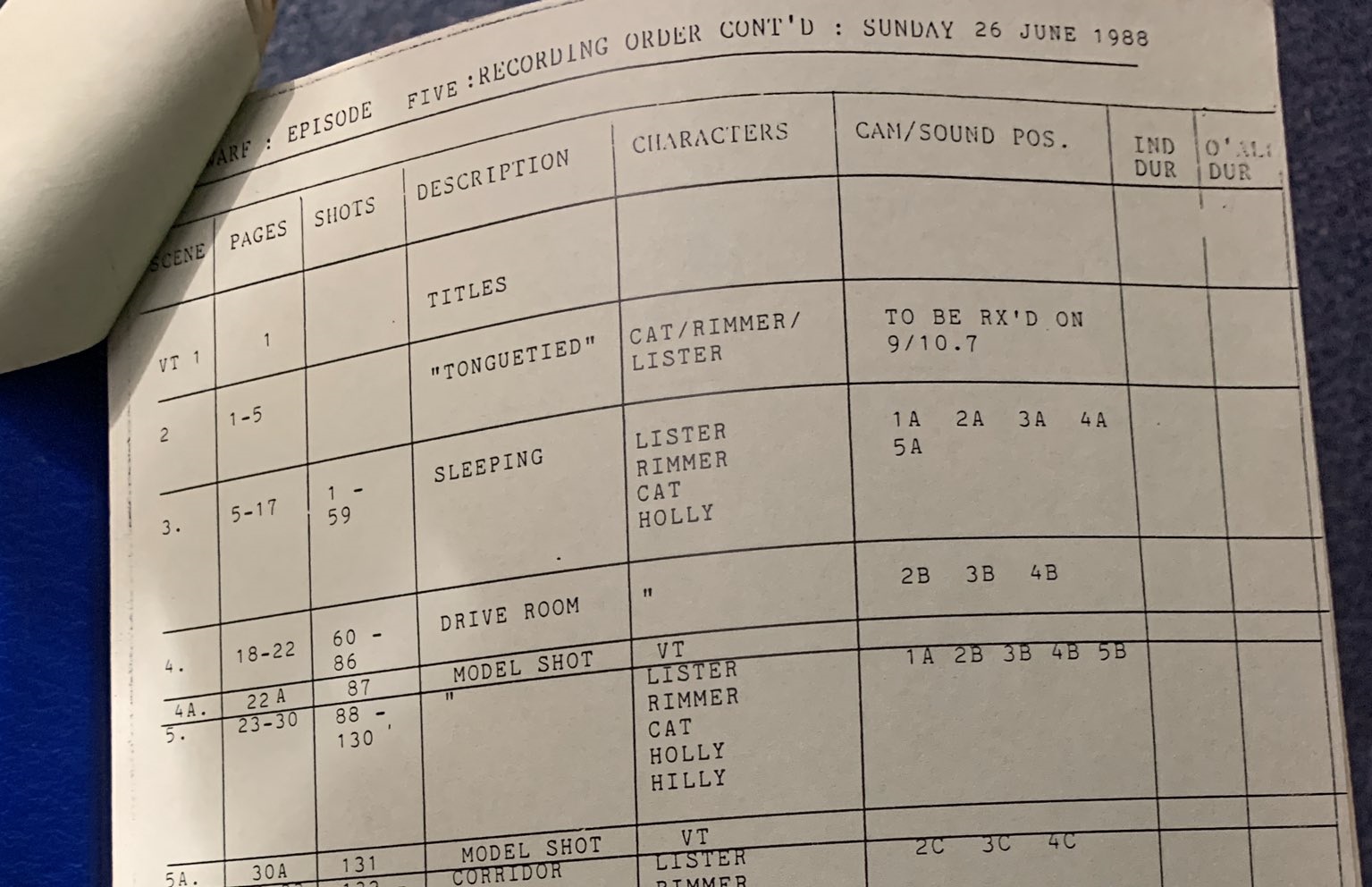
Hang on. Tongue Tied, “TO BE RX’D ON 9/10.7”? What the hell?
OK, time to back up a bit. As is usual for Red Dwarf – and, indeed, many sitcoms – Series 2 was not made in exactly the same order that it was transmitted in. Although “Parallel Universe” was recorded fifth, on the 25th/26th June 1988, it actually transmitted sixth and last. As for what was recorded sixth, that was the episode “Queeg”, on the 2nd/3rd July 1988.
It’s at this point that I hope you see where my shock came from. If the last show of the series was shot on the 2nd/3rd July 1988, what the hell was happening on the 9th/10th July? Surely the show would have wrapped by then?
Unless… hmmm. Let’s take a sneaky look at the paperwork for Series 2.

Bloody hell. Just like the first series, Series 2 of Red Dwarf had a pick-up week. A week of production that has – to my knowledge – never, ever been discussed before.3 Not even on the Bodysnatcher release.
Moreover, if we take a look at the paperwork for the music in “Parallel Universe”, we get this:
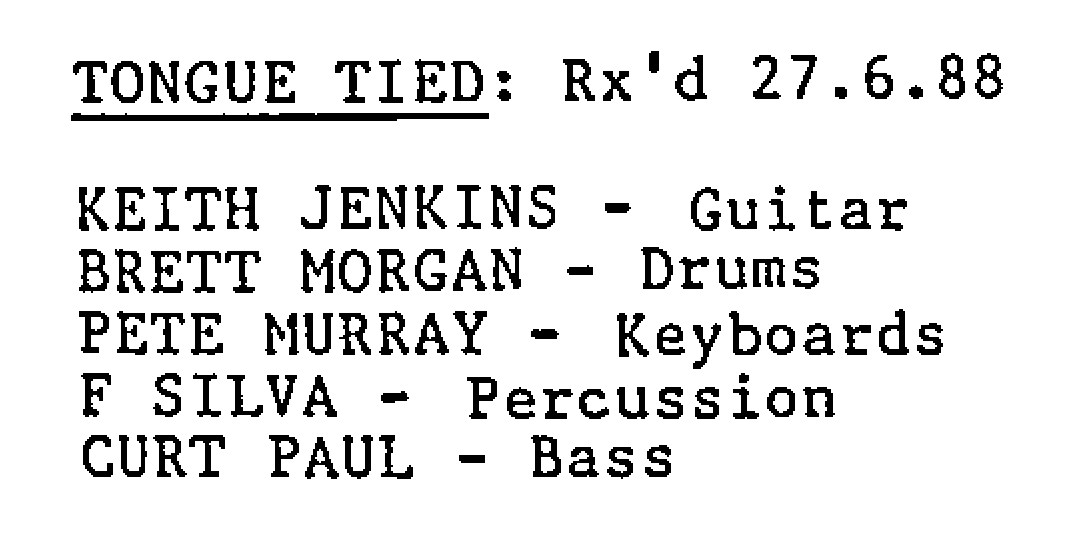
Remember, the bulk of “Parallel Universe” was actually shot on the 25th/26th June. The recording session for the backing track of “Tongue Tied” took place on the 27th… the day after the main audience studio record for the episode. In other words, absolutely nothing to do with the final version of “Tongue Tied” had been made by the end of the studio recording dates for “Parallel Universe”.
For final proof, we also helpfully have this:
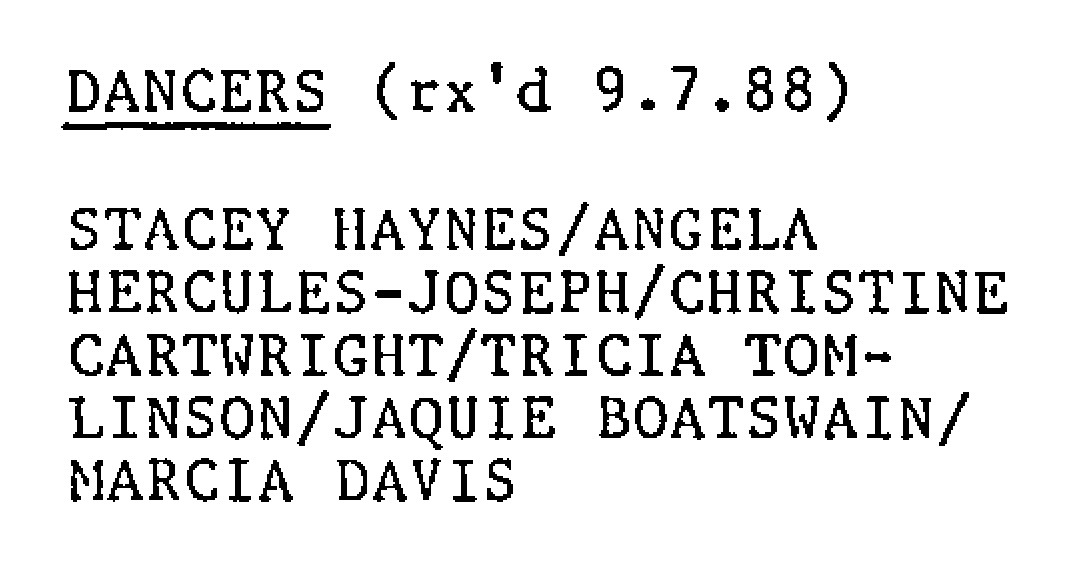
So the visuals for “Tongue Tied” were actually recorded on the 9th July 1988, the pre-record day of the pick-up week. And two weeks after the rest of “Parallel Universe” was shot.
All of which brings a different light to comments like this, in the Series 2 documentary on the Bodysnatcher release, where Chris Barrie recalls a clash between Ed Bye and choreographer Charles Augins:
CHRIS BARRIE: We spent about 75% of our rehearsal time working on that number. […] I seem to remember Ed Bye coming in, sort of saying “Have you finished with them yet?” He wanted to get on with rehearsing… “There is the other 80% of the show to do… the comedy, you know? Remember that? Sitcom?”
“It’s Cold Outside”, Red Dwarf: The Bodysnatcher Collection
I wouldn’t accuse Chris Barrie of entirely misremembering here. There probably was a clash between Bye and Augins about the time spent on “Tongue Tied”. But the anecdote surely has to be viewed in a slightly different light, now we know that the bulk of “Tongue Tied” would have been rehearsed in an entirely separate week to the rest of “Parallel Universe”.
It also brings a slightly new interpretation to Paul Jackson’s comments about the extra week of recording for Series 1, quoted at the start of this article. Again, nobody is wrong here. But there is a slight implication hanging around in the air that Series 1 of Dwarf “got away” with just delivering six episodes. But if exactly the same thing happened with Series 2, then it all becomes slightly less cheeky, and a little more… normal.4
Finally, one thing keeps coming to mind from all this research. Red Dwarf is often portrayed as both an underdog, and a series which was starved of money, especially in the beginning. But here’s the thing: most UK audience sitcoms in the 80s only had one day in the studio per episode. Not all of them, certainly; The Young Ones famously got a pre-record day as well. But plenty just got a single day. Not only did Red Dwarf get two days, but it also got a pick-up week; a total of 14 days in the studio for six episodes, when most sitcoms would have had… well, six.
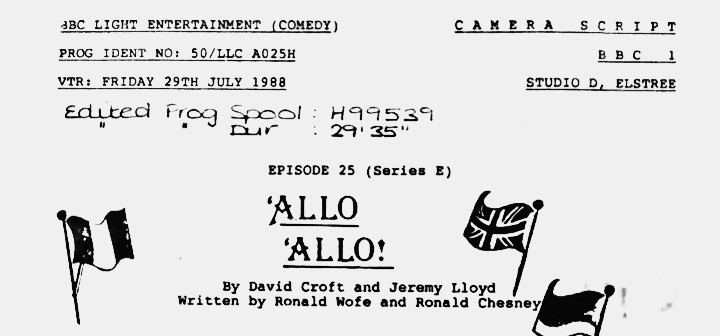
When viewed in that light, Red Dwarf seems rather less like an underdog, and more like a production that was… well, slightly privileged. I’m not saying they didn’t need that studio time; it was a hugely complicated show compared to most sitcoms. But it feels to me that there’s a bit of mythology built up about the show in this area, which isn’t fully warranted.
* * *
You may be wondering exactly what I’m driving at with all the above. Series 2 of Red Dwarf had two extra shooting days that we didn’t know about. So? And I get it. If you don’t care about production details like this, it’s going to come across as faintly ridiculous.
But for those that do care, this revelation is just extraordinary. For years, Dwarf fans have had an entirely incorrect idea of exactly how one of the most famous sequences in the show was made. Even the most committed fan of production minutiae thought that “Tongue Tied” was simply shot during the pre-record day of “Parallel Universe”, and then shown to the studio audience the next day. To find out that the music track hadn’t even been recorded when the bulk of “Parallel Universe” was shot, and that visual performance in the studio was recorded two weeks later, fair blows my mind. We just had no clue about this, and only discovered it three decades later.
Just imagine filing into the audience for “Parallel Universe”, sitting down to watch the show… and not actually seeing the section of the episode that became famous. That’s why this whole thing fascinates me so much.

“Parallel Universe” Audience Record,
26th June 1988
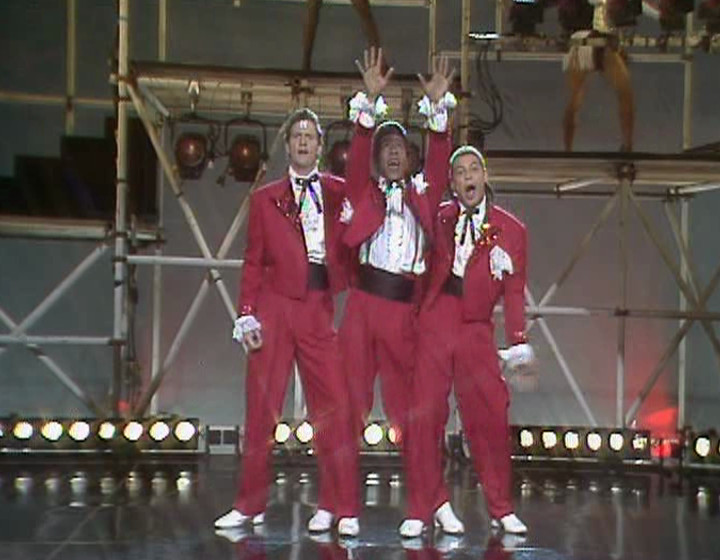
Red Dwarf Series 2 Pick-up Week,
9th July 1988
And finding this out three decades later is also strange. But then, that’s – hopefully – how these things work. People build on top of other people’s research, hopefully getting closer to some kind of vague truth. The Bodysnatcher release revealed the details about the extra week’s shooting for Series 1 for the first time; while not as an important, my revelations here about Series 2 are hopefully interesting in their own right.
With that in mind… if both Series 1 and Series 2 had a pick-up week, did Series 3? True, there were a lot of differences between Series 2 and Series 3, with Rob and Doug getting far more involved in terms of the production. But they were recorded at the same studio, with the same basic production schedule; four days of rehearsal, followed by two days in the studio.5 And crucially: if Series 3 did have a pick-up week, what exactly was recorded in it?
I have no idea. The paperwork I have access to reveals nothing. Maybe I’ll find out at some point… or maybe someone else will. Building on this research, just as I did with the Series 1 revelations.
I hold out the baton. Do you wanna grab it?
For more on this seventh week of recording, check out the Rob Grant/Ed Bye/Paul Jackson commentary for “The End”, from 13:56 in. ↩
Usual disclaimer: I know someone who worked on the DVD. Usual disclaimer to the disclaimer: I’d be saying it was great anyway. ↩
Aside from by yours truly on Ganymede & Titan, back in January 2020. Although most of this piece is brand new. ↩
The obvious question, then: surely “Tongue Tied” wasn’t the only thing shot during Series 2’s pick-up week? The answer is: no, it wasn’t. I don’t have all the details, but I do have some. Going into them is a little beyond the scope of this article, however. Stay tuned. ↩
Series 3 wasn’t recorded at weekends, however; the studio days were Monday/Tuesday, shifting to Tuesday/Wednesday later in the run. ↩

4 comments
Ade Jacobs on 2 June 2021 @ 10am
Another great article. Dirty Feed is fast becoming one of my favourite sites.
I wonder if the extra week was allocated because BBC Manchester were less busy than say Television Centre or studios near London. So maybe they were more relaxed in how much studio time they allocated to shows.
Not got the Blu-Rays and I appear to have missed out on the Bodysnatcher Collection so this is totally new information to me.
Maybe being slightly thick here, but I don’t understand the significance of the ‘Allo ‘Allo script picture.
Keep up the great work.
John Hoare on 2 June 2021 @ 10am
Cheers Ade!
The ‘Allo ‘Allo script picture is just to indicate that most sitcoms at the time only had one day’s studio recording. In that instance, Friday 29th July 1988.
Adam Tandy on 14 June 2021 @ 2pm
John —
The difference between the one-day and two-day stands in the studio is usually down to the originating department. The typical plan budget for a show out of the Variety department had two studios days allocated by Studio Planning. Allowed for orchestra rehearsal, dance rehearsal, some pre-recording for sketches. (Two Ronnies, Morcambe & Wise). It needed, and was given, the extra resources. A programme number with LLV in it indicates a Variety show. Jacko was a Variety producer, and his shows got the extra day. Young Ones, etc.
Programmes out of the Comedy Department were inherently more efficient with studio time (though often had filming resources allocated for inserts, of course). Those are the shows with LLC in their programme numbers.
And occasionally network production centres in Manchester, Birmingham, etc, had spare capacity and unallocated spend and picked up shows from London departments. Which is why RD has NMR in its programme number. That capacity possibly allowed for the additional week, which also improved the studio usage statistics. It’s a bit of internal horse-trading, possibly masterminded by M.L.E.(V.) Tony James.
Quite a lot of that sort of thing happened before Producer Choice turned the entire internal market into a fire sale.
— Adam
John Hoare on 15 June 2021 @ 5pm
Cheers Adam, that’s all very useful and much appreciated!
Comments on this post are now closed.